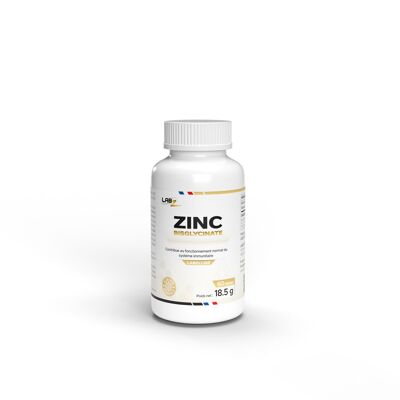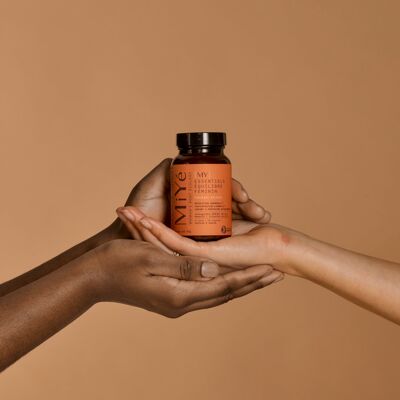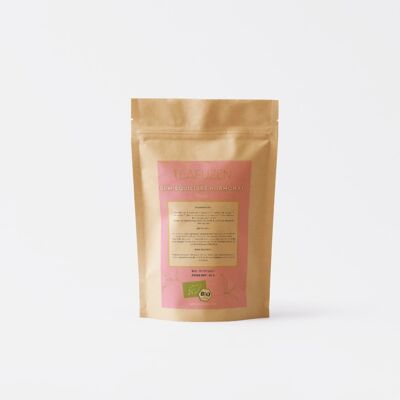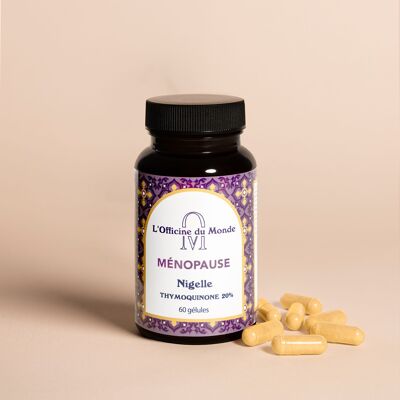


What is SPM Down? SPM Down is a dietary supplement formulated with natural active ingredients for menstrual comfort. Pre-menstrual syndrome (PMS) is a collection of physical and emotional symptoms that usually occur 2-7 days before your period (sometimes up to 14 days). They usually end with the onset of menstruation or within a few days. SPM Down has been formulated to soothe the main pre-menstrual symptoms. What will the SPM Down allow? ➢ Significantly relieve pain induced by inflammatory sites. ➢ No longer be dependent on mood swings, excessive emotionality and wavering morale. ➢ A generalized decrease in inflammation and better hormonal regulation, allowing to fight against acne attacks. ➢ Reduction of headaches thanks to better regulation of physiological functions, particularly in the pelvic and breast regions. 🌱 Vitamin B6 Vitamin B6 is an important cofactor (= an essential element) in the synthesis of serotonin, dopamine (well-being hormones) and GABA (molecules that calm the brain). Deficiencies (=lack) in each of these neurotransmitters have been implicated in PMS, particularly mood disorders. Thus, a daily dose of vitamin B6 could, according to the authors, bring relief in the irritability felt in some women during their premenstrual period by increasing the levels of serotonin, the hormone of well-being, and GABA1,2 1 .Wyatt KM., et al. (1999). Efficacy of vitamin B6 in the treatment of premenstrual syndrome. Systematic review. BMJ, 82(6), 906-11. 2. Chocano Bedoya, PO., et al. (2011). Dietary B vitamin intake and incident premenstrual syndrome. The American Journal of Clinical Nutrition. 93(5): 1080-6. Chaste tree (Vitex agnus castus) The fruit of this plant has been used for a very long time by women to relieve menstrual disorders. Chasteberry has a dopaminergic effect (= stimulates the production of dopamine, a hormone) inducing a decrease in the release of prolactin (= hormone causing breast swelling during pregnancy and breastfeeding) originally mastodynia (= breast pain).,1,2,3,4,7,8,9,10 In addition, this plant has the most effective progesterone action (= helps to increase progesterone levels)5, 4. Finally Chaste Tree would play a role in reducing the level of circulating endorphins, in particular endogenous opioids which are responsible for regulating perception, pain, mood or appetite 4,6,9,10. A meta-analysis also listed the studies which demonstrated the usefulness of chasteberry in endometriosis11 (Inhibition of the Nf-kB pathway; B-endorphin-like analgesic activity on the μ opioid receptors; antidepressant action by inhibition of the reuptake of serotonin; increase in the concentration of melatonin promoting sleep). 1. Sliutz G, Speiser P, Schultz AM, Spona J, Zeillinger R. Agnus castus extracts inhibit prolactin secretion of rat pituitary cells. Hormone and Metabolic Research. 1993; 25:253–255. 2. Jarry, H., Leonhardt, S., Gorkow, C. and Wuttke, W.: In vitro prolactin but no LH and FSH release is inhibited by compounds in extracts of Agnus-castus: direct evidence for a dopaminergic principle by the dopamine receptor assay. Clin. Endocrinol. 102: 448-454, 1994. 3. Wuttke W, Jarry H, Christoffel V, Spengler B, Seidlova-Wuttke D. Chaste tree (Vitex agnuscastus): pharmacology and clinical indications. Phytomedicine. 2003; 10:348–357. [PubMed: 12809367] 4. Meier B, Berger D, Hoberg E, Sticher O, Schaffner W. Pharmacological activities of Vitex agnus-castus extracts in vitro. Phytomedicine. 2000; 7:373–381. 5. Milewicz A, Geideil E, Sworen H et al. Vitex agnus castus extract in the treatment of luteal phase defects due to latent hyperprolactinemia. Results of a randomized placebo-controlled double blind study. Arnzneimittel Forsch 1993; 43: 752-756 6. Webster DE, Lu J, Chen SN, Farnsworth NR, Wang ZJ. Activation of the mu-opiate receptor by Vitex agnus-castus methanol extracts: Implication for its use in PMS. J Ethnopharmacol. 2006; 106:216–221. 7. Meden-Vrtovec H., et al. (1992). Bromocriptine in the ocriptine in the management of PMS. Clin Exp Obst Clin Exp Obstet gynecol, 19:242 1992;19:242-248) 8. Berger D. et al. (1999). Klinisch kontrollierte Anwendungsbeobachtung beim prämenstruellen menstruellen Syndrom. Zeitschrift für Phytoth erapie, 20:155-156. 9. Berger D. et al. (2000). Efficacy of vitex agnus castus L.extract Ze 440 in patients with PMS. Arch Gynecol Obstet, 264: 150-153. 10. Brattström A. el al. (1999). Behandlung des prämenstruellen Syndroms mit dem Mönchspfeffer Extract Ze 440 –Eine prospektive, doppleblinde, doppleblinde, randomisierte, Placebo-kontrolliere, multi zentrische Studie, 1999. 11. Reid R, Steel A, Wardle J, Adams J. Naturopathic Medicine for the Management of Endometriosis, Dysmenorrhea, and Menorrhagia: A Content Analysis. J Altern Complement Med N Y N. 2019 Feb;25(2):202-26. Lady's mantle (Alchemilla vulgaris) This plant is a phytoprogestagen. Phytoprogesterone is a molecule similar to progesterone naturally synthesized by the body, which allows it to exert a similar action. In addition, it is haemostatic, antidiarrheal and allows better venous circulation. A meta-analysis also identified studies that demonstrated the usefulness of Yarrow in endometriosis (Limits the progression of endometriosis by inhibiting the formation of endometriotic cysts and adhesions. Decrease in concentrations of TNF⍺, VEGF and IL-6)3 1. Dias MC, Furtado KS, Rodrigues MAM, Barbisan LF. Effects of Ginkgo biloba on chemically-induced mammary tumors in rats receiving tamoxifen. BMC Complement Altern Med [Internet]. 2013 Dec [cited 2016 Oct 28];13(1). 2. Brinker FJ. Herbal contraindications and drug interactions plus herbal adjuncts with medicines. 4th ed. Sandy, OR: Eclectic Medical Publications; 2010. 598 p. 3. Reid R, Steel A, Wardle J, Adams J. Naturopathic Medicine for the Management of Endometriosis, Dysmenorrhea, and Menorrhagia: A Content Analysis. J Altern Complement Med N Y N. 2019 Feb;25(2):202-26. Yarrow (Alchillea millefolium) This is a phytoprogestagen plant (= mimics the action of progesterone), antispasmodic (= reduction of uterine and intestinal spasms causing pain), anti-inflammatory (= reduction of inflammation at the origin of the pain), pelvic decongestant (= reduction of the blood flow in the vessels of the uterine lining at the origin of the pain) and it tends to improve digestion which can sometimes be turned upside down during the menstrual cycle1,2,3,4,5,6,7 A meta-analysis has also identified studies that have demonstrated the usefulness of Yarrow in endometriosis (8 Reduction in the volume of endometriotic lesions. Reduction in TNF⍺, VEGF and IL-6 concentrations). 1. Gladstar R. Herbal Healing for Women. New York: Simon and Schuster, 1993. 2. Wood M. The Book of Herbal Wisdom: Using Plants as Medicines. California: North Atlantic Books, 1997 3. Hendler S, Rorvik D. PDR for Nutritional Supplements. New Jersey: Thomson Reuters, 2008. 4. Gladstar R. Herbal Healing for Women. New York: Simon and Schuster, 1993. 5. Bliss F. Herbs in Gynecology. J Naturopath Med 1950;2:10–11. 6. Fisher C. Materia Medica of Western Herbs. New Zealand: Vitex Medica, 2009. 7. Gladstar R. Rosemary Gladstar's Herbal Recipes for Vibrant Health: 175 Teas, Tonics, Oils, Salves, Tinctures, and Other Natural Remedies for the Entire Family. Massachusetts: Storey Publishing, 2008 8. Reid R, Steel A, Wardle J, Adams J. Naturopathic Medicine for the Management of Endometriosis, Dysmenorrhea, and Menorrhagia: A Content Analysis. J Altern Complement Med N Y N. Feb 2019;25(2):202-26 Black Cohosh (Cimicifuga racemosa) This plant is antiestrogen (selective estrogen receptor modulator) (= decreases the number of receptors that bind estrogen in order to reduce their effects) without any estrogenic action (= without mimicking the action of estrogen) at menopause, sedative anxiolytics (= reduction of anxiety by soothing the excitability of the brain)1 and antispasmodic (= reduction of uterine and intestinal spasms source of pain)2,3,4,5,6,7. A meta-analysis also identified studies that demonstrated the usefulness of Lady's Mantle in endometriosis8,9. 1. Williamson EM, Stockley IH, editors. Stockley's herbal medicine interactions: a guide to the interactions of herbal medicines. 2. ed. London: Pharmaceutical Press; 2013. 512 p 2. Scudder J. Dysmenorrhea. Eclectic Med J 1877;37:290 3. Webster H. Cimicifuga racemosa. Eclectic Med J 1901; 61:195–198. 4. Felter H. Properties and uses of Cimicifuga racemosa (Macrotys Racemosa, Black Cohosh, Traubiges Wanzenkraut). Bull Lloyd Library Bot Pharm Mater Med 1912;19:98–100. 5. Felter H. Macrotys. Eclectic Med J 1922;82:411–413. 6. Milton J. Women's Foods: Cause and Treatment. Naturopath Herald Health 1941;46:324–337 7. Neal R. Cimicifuga racemosa. Naturopath Herald Health 1941;46:71–82. 8. Reid R, Steel A, Wardle J, Adams J. Naturopathic Medicine for the Management of Endometriosis, Dysmenorrhea, and Menorrhagia: A Content Analysis. J Altern Complement Med N Y N. 2019 Feb;25(2):202-26 9.Raynaud J. Aromatherapy prescription and advice. 2006. 247 p. (Lavoisier) Pycnogenol®️ Pycnogenol®️ is an active ingredient 100% extracted from the bark of the Landes maritime pine. It contains OPC (oligp-proanthocyanidins), a molecule from the family of flavonoids (polyphenols). Pycnogenol is a patented active ingredient which, thanks to its powerful anti-inflammatory and antioxidant properties, reduces the symptoms and pain of women suffering from PMS3,4,6,7. Several studies in women with endometriosis have also been carried out1,2,5,6,7 (Inhibition of COX-2, lipo-oxygenase, NF-kB pathway; reduction of pain related to endometriosis and reduced consumption of NSAIDs). 1.CLINICAL STUDY: The combination of oral contraceptives with Pycnogenol® shows a positive synergetic effect on the eutopic endometrium of endometriosis patients. Maia H, Haddad C, Pinheiro N, Casoy J The Effect of Oral Contraceptives Combined With Pycnogenol (Pinus Pinaster) On Aromatase and VEGF Expression in the Eutopic Endometrium of Endometriosis Patients. Gynecol Obstet 4:2, 2014 2. CLINICAL STUDY: Pycnogenol® taken with oral contraceptives alleviates endometriosis related pain. Maia H, Haddad C, Casoy J Combining oral contraceptives with a natural nuclear factor-kappa B inhibitor for the treatment of endometriosis-related pain. Int J Womens Health 6: 35-39, 2014 3. CLINICAL STUDY: Pycnogenol® significantly improved peri-menopausal symptoms at relatively low daily dosage of 60 mg and was demonstrated to not interfere with sexual hormone levels. Kohama T, Negami M Effect of low-dose French maritime pine bark extract on climacteric syndrome in 170 perimenopausal women. J Reprod Med 58(1-2): 39-46, 2013 4. CLINICAL STUDY: Pycnogenol® significantly lowers menstrual pain and the quantity of required analgesic medication in a multi-center study with four hospitals in Japan. Suzuki N, Uebaba K, Kohama T, Moniwa N, Kanayama N, Koike K French Maritime Pine Bark Extract Significantly Lowers the Requirement for Analgesic Medication in Dysmenorrhea. A multicenter, randomized, double-blind, placebo-controlled study. J Reprod Med 53: 338-346, 2008 5. CLINICAL STUDY: Pycnogenol® reduces pain from endometriosis, shows less side effects than hormonal treatment and enabled some women to conceive. Kohama T, Herai K, Inoue M Effect of French Martime Pine Bark Extract on endometriosis as compared with Leuprorelin acetate. J Reprod Med 52: 703-708, 2007 6. CLINICAL STUDY: Pycnogenol® produces analgesic effect in gynaecological disorders such as endometriosis and dysmenorrhea. It reduces menstrual cramps, abdominal pain and tenderness. Kohama T, Suzuki N, Ohno S, Inoue M Analgesic efficacy of French maritime pine bark extract in dysmenorrhea. An open clinical trial. J Reprod Med 49: 828-832, 2004 7. CLINICAL STUDY: Pycnogenol® helps in gynaecological disorders such as endometriosis and dysmenorrhea. It reduces menstrual cramps, abdominal pain and tenderness. Kohama T, Suzuki N The treatment of gynecological disorders with Pycnogenol®. Eur Bull Drug Res 7: 30-32, 1999 Milk thistle (Sylibum marianum) Milk thistle is a hepatic draining plant (= helps the liver to perform its role of detoxifying, i.e. eliminating waste of the body) which helps support the liver in the elimination of excess esotrogens at the origin of the hormonal imbalances themselves at the origin of the PMS. This is mainly explained by the presence of silymarin, a flavonoid complex, in its composition1 A meta-analysis has also identified studies that have demonstrated the usefulness of Milk Thistle in endometriosis3 (Inhibits TNF⍺)2. 1. Foster S. “Milk Thistle.” Nutrition News, Volume 12, 1989. 2. Reid R, Steel A, Wardle J, Adams J. Naturopathic Medicine for the Management of Endometriosis, Dysmenorrhea, and Menorrhagia: A Content Analysis. J Altern Complement Med N Y N 2019 Feb;25(2):202-26 L-tryptophan L-tryptophan is the precursor (= molecule that is made before the final molecule) of serotonin. During a woman's menstrual cycle, L-tryptophan levels can fluctuate, preventing enough serotonin from being made, which can lead to the mood swings experienced in PMS. Taking L-tryptophan significantly reduces mood swings and irritability in women with PMS 1,2,3 1. Hrboticky, N., et al. (1989) Menstrual cycle effects on the metabolism of tryptophan loads. Am J Clin Nutr, 50(1): 46-52. 2. Steinberg, S., et al. (1999). A placebo-controlled clinical trial of L-tryptophan in premenstrual dysphoria. Biol Psychiatry; 45(3): 313-20. 3. Freeman,EW. (2004). Luteal phase administration of agents for the treatment of premenstrual dysphoric disorder. CNS Drugs 2004; 18(7); 453-68. ORGANIC borage and evening primrose oil Evening primrose and borage oils are rich in gamma-linolenic acid (GLA) which is a precursor (= molecules produced before the final molecule) of the synthesis of type 1 prostaglandins which have a anti-inflammatory and relaxing effect. Type 1 prostaglandins (PG1) counteract the effects of type 2 prostaglandins, which are pro-inflammatory and can cause the pain felt during PMS. Several studies have shown that a decrease in PG1 synthesis is responsible for PMS and that correcting the PG1 deficiency can reduce the biological effects of prolactin and provide relief to women suffering from PMS1,2,3,4. This deficit would be due to a dysfunction of the delta-6-desaturase. A meta-analysis5 also identified studies that demonstrated the usefulness of borage and evening primrose oils in endometriosis6 (Reduction of pain and risk of endometriosis). 1. HORROBIN D.F. The Role of Essential Fatty Acids and Prostaglandins in the Premenstrual Syndrome. Repr. Medi., 1983, 28 (7), 465-8. 2. BRUSH M.G., WATSON S.J., HORROBIN D.F., MANKU M.S. Abnormal essential fatty acid levels in plasma of women with premenstrual syndrome. Am. J. Obstet. Gynecol., 1984, 150 (4), 363-6. 3. ZIBOH V.A., FLETCHER M.P. Dose response effects of dietary y-linolenic acid enriched oils on human polymorphonuclear-neutrophil biosynthesis of leukotriene B4. Am. J. Clin. Nutr., 1992, S2, 39-45. 4. ZERVOUDIS S: Communication at the congress of the European society of gynecology. Helsinki. Jun 2005. 5. Reid R, Steel A, Wardle J, Adams J. Naturopathic Medicine for the Management of Endometriosis, Dysmenorrhea, and Menorrhagia: A Content Analysis. J Altern Complement Med N Y N. 2019 Feb;25(2):202‑26 6. Leplat M. Endometriosis: Breaking taboo and improving care. Pharmacist's contribution If regular cycles: Take 2 to 3 capsules per day from the 14th day (ovulatory period) to the 1st day of menstruation. If irregular cycles: Take 2 to 3 capsules per day 15 days after your last period for 10 to 15 days. Precautions for use: SPM DOWN is not recommended for women with PCOS. In PCOS, the level of LH is often very high compared to FSH. In this situation chaste tree in particular, risks leading to a rise in LH and exacerbating certain symptoms of the syndrome. The SPM DOWN is not recommended for pregnant and breastfeeding women. Indeed, pregnant women cannot be affected by PMS since they are amenorrhea. Breastfeeding women should avoid taking SPM DOWN because it contains chaste tree which is a plant that helps to lower the level of prolactin, the lactation hormone. SPM DOWN is not recommended for young girls who have never had their first period as well as for postmenopausal women. Nutritional information for 3 capsules: Organic Borage Oil - 282.39 mg; L-Tryptophan - 220mg; Evening Primrose Oil Powder - 205.35 mg; Chaste Tree Fruit dry extract - 112.95 mg; Milk thistle dry extract - 90.36 mg; Yarrow dry extract - 90.36 mg; Alchemilla dry extract - 58.74 mg; Cohosh dry extract - 45.18 mg; Pycnogenol™ (maritime pine extract) - 21 mg; Vitamin B6 - 2.7 mg, i.e. 194% of NRV*. *Nutritional Reference Values List of ingredients: Glazing agent: Pullulan; Borage oil 40% (Gamma-linolenic acid 20%) microencapsulated ORGANIC; L-Tryptophan; Evening primrose oil powder (55% Bertin); Chaste Tree Dry Extract (Vitex agnus-castus) Fruit 4/1; Milk Thistle Dry Extract 20/1 80% silymarin (Silybum marianum); Yarrow Dry Extract 4/1 (Achillea millefolium L); Lady's Mantle Dry Extract 4/1 (Alchemilla vulgaris L); Black Cohosh Dry Extract (Cimicifuga racemosa) 2.5% triterpenoid; Pycnogenol™ (maritime pine extract); Vegan- From what age can we take SPM DOWN? Theoretically speaking, the PMS DOWN can be taken as soon as the first menses appear if the young woman already suffers from PMS. Of course, if the young woman is still a minor, she will have to ask permission from her legal guardian and her doctor before taking it. Can SPM DOWN have an impact on period regularity? If the SPM DOWN is taken at the time indicated on the instructions for use, no. In addition, there are a multitude of factors that can disrupt a menstrual cycle: stress, illness, unannounced pregnancy... so it is very complicated to make any correlation between taking the supplement and a negative change. in the regularity of the rules. Is there a risk if SPM DOWN is taken outside the recommended period? Theoretically, since some plants contained in SPM DOWN are progesteron-like or phytoestrogens, there would be a possibility that hormonal fluctuations/modifications also occur during these periods. But that's not the goal. Nevertheless, no study has revealed changes in the hormonal cycle after the use of one or more of the active ingredients contained in SPM DOWN outside the recommended period. Why can't SPM DOWN be taken in the case of PCOS? In PCOS, the level of LH is often very high compared to FSH. In this situation chaste tree in particular, risks leading to a rise in LH and exacerbating certain symptoms of the syndrome. How long should I take SPM DOWN? One box of SPM DOWN corresponds to 1 cycle. It is therefore taken continuously from ovulation until the start of menstruation (luteal phase). You can start taking PMS Down when you have your first period, if you suffer from PMS, and continue it until your menopause period. On the other hand, if you are experiencing a period of amenorrhea or are expecting a child, it is not necessary to take the SPM down during these periods but you can take it again afterwards. However, the trial must be for a minimum of 3 months. What are the expected effects? The expected effects after taking SPM DOWN (after at least 3 months of use) are: - Relief of pain induced by inflammatory sites (pelvic and breast pain) - No longer dependent on mood swings - Reduce water retention - Have better hormonal regulation over the long term - Reduce hemorrhagic flows (excluding wearing a copper IUD)




















